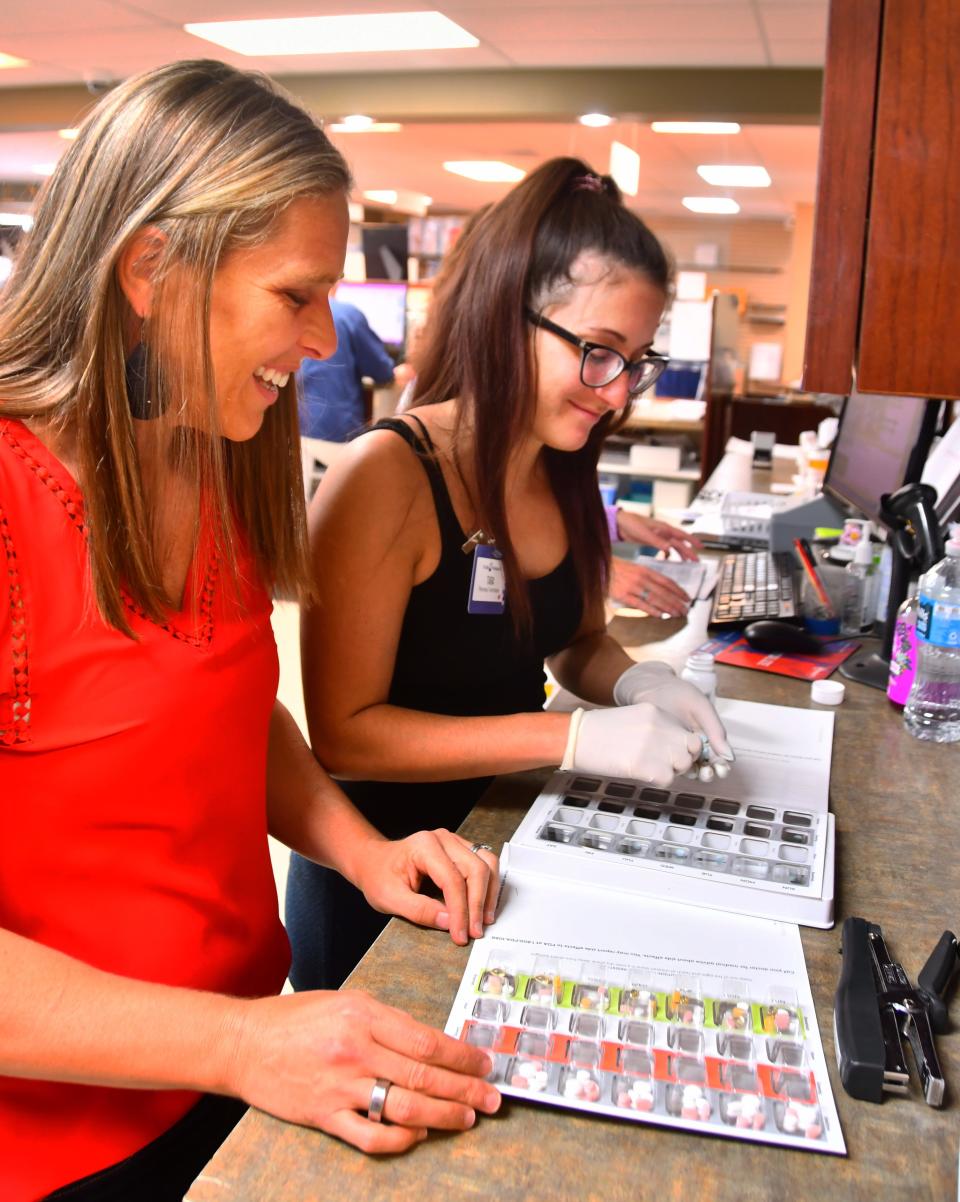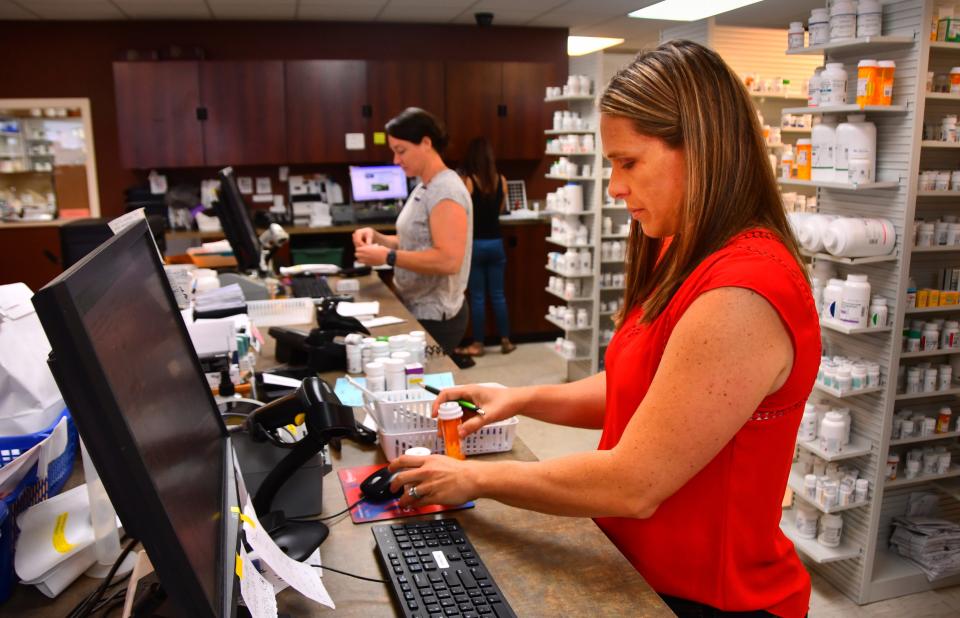New law opens path for Brevard pharmacies to test and treat some diseases
- Oops!Something went wrong.Please try again later.
At the height of the pandemic some of the patients who receive their medications at Hobbs Pharmacy in Merritt Island saw Jessica Beal, a pharmacist at Hobbs, more than they saw their primary care physicians.
Now, thanks to legislation passed in 2020, Beal is applying to joi one of only two other pharmacists in Brevard County who can treat patients for minor illnesses, such as flu and lice.
These developments are new. Though pharmacology has existed in the US since the 1800’s, pharmacists like Beal in Florida could only vaccinate for the flu since 2007. Then when the pandemic hit, legislation was introduced to allow pharmacists to test and treat.
One Senior Place: Prescription drug costs can be financially crippling to fixed budget seniors
COVID-19: cases increase as Space Coast remains a community of high transmission
If her application is successful, Beal and Hobbs Pharmacy would be one of three pharmacists who can test and treat in Brevard and one in of 72 in the state of Florida, according to data from the Florida Department of Health.
According to health care experts, the law allowing pharmacists to play a greater role in treating basic conditions could expand health access to low income people amid a healthcare landscape that faces doctor shortages and high medical costs.
Currently, Florida Department of Health data shows there are about 55,809 actively practicing physicians in Florida of which 5,107 say they are planning on retiring in the next five years, and 2,464 plan on relocating. Yet, the population in Florida grew by 14.6% from 2010 to 2020, to Census data, meaning population growth is outpacing the availability of physicians in the Sunshine State.
But, in Florida, because of current legislation, independent pharmacists like Hobbs pharmacy face financial barriers to becoming certified. According to experts, part of the barriers come from lobbying by doctors groups who want to keep regulations on pharmacists testing and treating tight.

History with vaccines
According to Sarah Steinhardt, professor of pharmacology at the University of Southern Florida, pharmacists have worked with vaccines going back to the 1800s soon after the the smallpox vaccine was first developed.
Steinhardt added that pharmacists must go through rigorous training before entering the profession, including college degrees, residencies and board certifications. Yet, Steinhardt added that, “spreading awareness of the clinical expertise pharmacists have to offer is an ongoing responsibility and process.”
But it wasn’t until 1994 that the Washington State Pharmacist Association developed a program to train pharmacists to administer vaccines. Nationwide, the American Pharmacists Association began its program in 1996.
Pharmacists in Florida didn’t start vaccinating against the Flu until 2007. From 2012-2015 pneumococcal, shingles, epinephrine added meningococcal vaccine and CDC adult immunization vaccines were all added to the last of diseases pharmacists could vaccinate against in Florida.
According to Steinhardt, the lag in legislation has been because of, “physician opposition to the pharmacist immunization bills, so authority has been expanded slowly over time.”
Additionally, pharmacists in Florida can only administer the flu vaccine to individuals seven years of age and older.
“We are behind other states in ability to administer childhood vaccines,” Steinhardt said.
COVID changed things
According to Ge Bai, professor of public health at John Hopkins University, prior to the pandemic, American’s weren’t testing themselves for viruses.
But when the pandemic hit, and test sites and self test kits popped up everywhere.
Then, the US Department of Health and Human Services allowed pharmacists to dispense the COVID-19 vaccine. And according to James Broughel, professor and economist George Mason University's Mercatus Center, most people got vaccinated at their local pharmacy, showing how vital a role pharmacists plaid in the pandemic.
A family and world united by grief:COVID's continued, shattering impact | Kennerly
Also: Arizona College of Nursing to establish campus in Melbourne at Rialto Place Office Tower
Bai said the pandemic also showed that when it comes to minor ailments, most Americans want fast, low cost treatment. A doctor appointment can be the opposite of that: It can take days to book an appointment at a doctors office if a patient has mild symptoms.
A survey from the Space Coast Health Foundation found that about 55% of Space Coast residents had some type of delay or difficulty when it came to accessing healthcare. This could mean that they live too far away from a provider, had a hard time getting an appointment or costs were to high.
Without insurance a doctors visit can cost upwards of $171, according to a cost comparison chart from Scripted Health, a platform that works to help pharmacists facilitate test to treat programs and the platform that Hobbs Pharmacy will use once they are certified to test to treat patients.
“But, if you can just go to your nearest pharmacist, your pharmacy is everywhere right? They can talk to their pharmacist, state, ‘This is my condition.’ They can just walk in and pay a much lower price for that consultation,” Bai said.
This can especially crucial for those who don’t have insurance or are underinsured which, according to FDOH, is about 11% of Brevard County.
In the future, customers who go to Hobbs Pharmacy with mild symptoms of flu or who want birth control would pay about $40, according to the Scripted cost comparison chart— nearly four times less than they would pay at a doctors office.
And pharmacies are almost always open.
Even when the delta variant of the novel coronavirus was raging, Hobbs Pharmacy never shut their store. They implemented CDC protocols, but patients were still able to come in and walk in the store and talk to Beal or a pharmacy technician.

“I feel like I spent hours discussing with patients on supplements to improve their immune system ways to improve their health,” said Beal, who was raised in Merritt Island and has known some of her customers since she was a kid.
Beal said they inquiries from patients asking if they can test for things like the flu and if they can receive treatment for it. Beal said, “And usually I have to say yes I can test for it but no, I’d have to refer you to a primary care to get treatment.”
Not replacing doctors
Under the Florida law passed in 2020 that allows pharmacists to test and treat, pharmacists can only treat a handful of conditions and the guidelines are rigorous.
The law states that, pharmacists can only treat “influenza, streptococcus, lice, skin conditions, and minor, uncomplicated infections.” If a patient comes in with the flu and has a fever of 102 degrees, Beal would have to tell them to go to the hospital.
But Beal and other pharmacists aren’t looking to replace doctors.
“If someone walks in here and it is clear to us as health care professionals they need to go to the emergency room right now ... We’re not going to try and treat them; we’re going to send them to the Cape (Canaveral Hospital) or wherever (hospital) they go,” said Mark Hobbs, owner of Hobbs Pharmacy. “That’s part of the triage and that’s part of the training.”
Beal must go through a 20 hour certification program and ongoing training to be able to test and treat.
“We’re not trying to perform anything other than some real primary care,” said Hobbs.
The law also stipulates that pharmacists must ask for patient medical history and any medication they might be currently taking. And they need to have a patient record keeping system in place to keep track of this. And pharmacists need to have a supervising physician who can oversee the pharmacist. The physician also needs to purchase malpractice insurance that covers the partnership — a requirement that is often a barrier for pharmacies like Hobbs.
Because malpractice insurance can be expensive, it disincentives doctors from partnering with pharmacists who want to provide test and treat options for their patients. And, offering to pay for the insurance for the doctor can be a financial burden on small businesses like Hobbs Pharmacy that have to compete with CVS, Walgreens and Publix.
Regulations and supply and demand
“You’re not going to see a lot of these agreements because the physicians really don’t benefit from it,” Broughel said.
Broughel first started looking into pharmacy regulations when he found out that Idaho overhauled laws regulating pharmacists. In Idaho, pharmacists have some of the most expansive prescribing authority and can prescribe over 20 drugs, said Broughel. More pharmaceutical practice have opened in Idaho because of this.
Broughel doesn’t expect every state to be like Idaho, however, he said that part of the reason there has been so much resistance to pharmacists prescribing medications is because of medical associations lobbying efforts.
“Physicians don’t like pharmacists having this authority, and the medical profession has had a lot of clout, a lot of influence for a long time, and it seems likely that they probably had some influence in determining how other professions that they compete with are regulated,” said Broughel.
The current physician shortage not only puts strain on the healthcare system as a whole but it also impacts how much health care can cost.
Bai added that when only doctors are able to test and treat for these basic ailments, they can upcharge as much
“When you increase the supply of something then the price should fall,” said Broughel. “And then at the end of the day, if you have better access to health care if your saving money, there’s economic benefits and there's presumably some health benefits as well.”
As more pharmacists have organized together and communities saw how vital pharmacists were in dispensing vaccines during the pandemic, slowly, pharmacists are starting to gain more political momentum.
“These are highly trained skilled medical personnel who can be doing a lot more than just counting pills and putting them in a bottle,” Broughel said.
The changes brought about during the pandemic may not be huge, added Broughel but they “are a step in the right direction.”
Despite the obstacles, Beal is excited about these changes.
Her pharmaceutical philosophy is based on providing access and care to the community she grew up in. Adding test to treat to the repertoire of services she provides to patients at Hobbs Pharmacy will be another way for her to help better care for Merritt Island, she said.
Amira Sweilem is the data reporter at FLORIDA TODAY. Contact Sweilem at 386-406-5648 or asweilem@floridatoday.com.
Support local journalism. Subscribe today.
This article originally appeared on Florida Today: Brevard pharmacists can test and treat some illness under pandemic law

